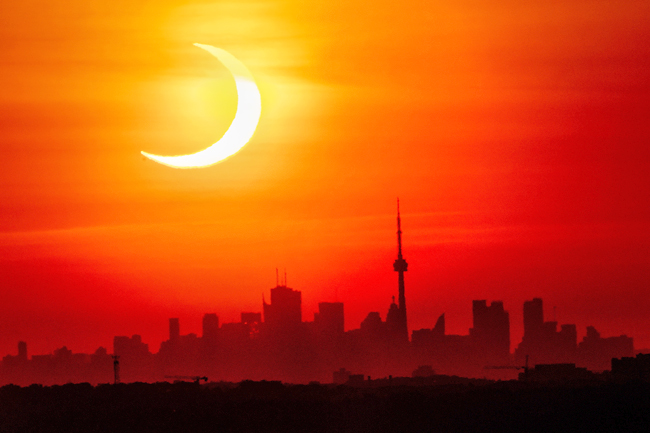PARIS (AFP) – The moon will cross in front of the Sun for around four hours tomorrow, creating a partial solar eclipse that careful skygazers will able to see in parts of the Northern Hemisphere.
The eclipse will stretch from eastern Canada to northern Russia, and potentially be visible in most of Europe and some areas of northeastern North America and northwest Africa, according to France’s Paris Observatory.
The eclipse will begin at 0850 GMT and end at 1243 GMT.
The relatively rare celestial event occurs when the Sun, Moon and Earth all line up. A total solar eclipse is when the moon totally blots out the Sun, creating an eerie twilight.
But this time, the Moon will cover at most 90 per cent of the Sun in some northern latitudes, turning the Sun’s rays into “cold light”, Paris Observatory astronomer Florent Deleflie told AFP.

The maximum amount of eclipse will be visible in northeastern Canada and Greenland at 1047 GMT.
It will be less spectacular in other areas. In France, for example, between 10 to 30 per cent of the Sun’s disc will be obscured, depending on the region.
“The naked eye will not be able to see any difference,” Deleflie said.
People wanting to see the moon apparently take a bite out of the Sun will need to take precautions.
Looking straight at the Sun – during an eclipse or otherwise – can lead to irreversible vision loss.
“Using special glasses is one solution,” Deleflie said.
However if the glasses are not new, even a slight defect or “microscopic hole” can cause eye damage, he warned, advising people to try observing an eclipse at a local astronomy observation centre. There, “you can safely verify the precision of celestial mechanics and marvel at interesting details on the Sun’s surface, such as sunspots”, he said.
The partial eclipse will not turn up on a smartphone camera without a suitable filter, Deleflie added.
“The light is so intense that the obscured part won’t appear.”
The latest celestial show will come two weeks after skygazers across much of the world marvelled at a rare total lunar eclipse, dubbed a ‘Blood Moon’.
Saturday’s partial solar eclipse will be the first of the year, and the 17th of this century.





